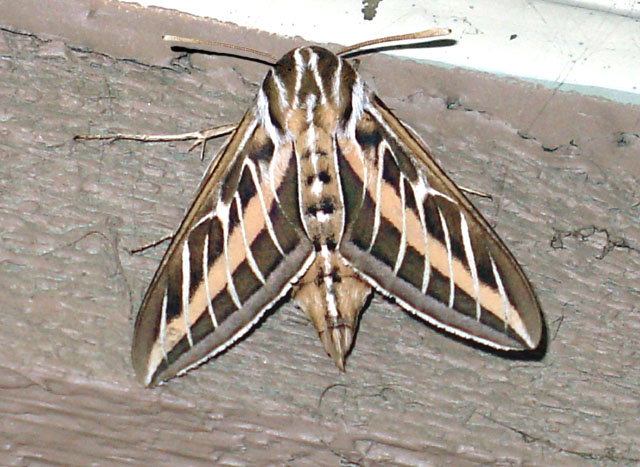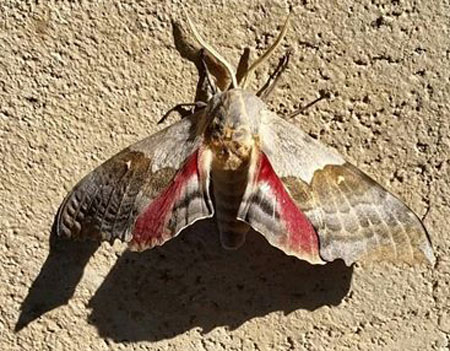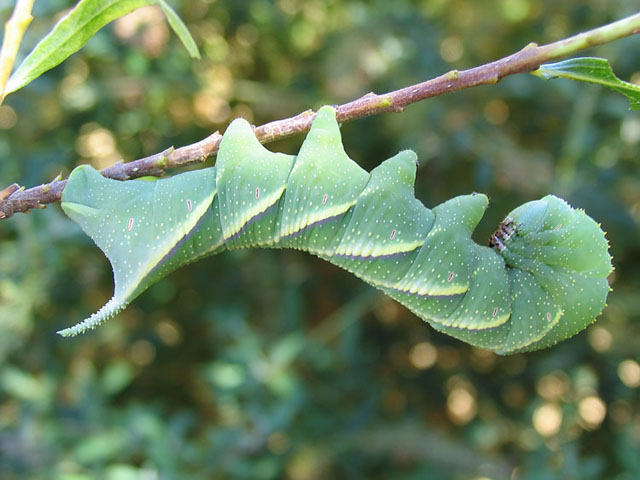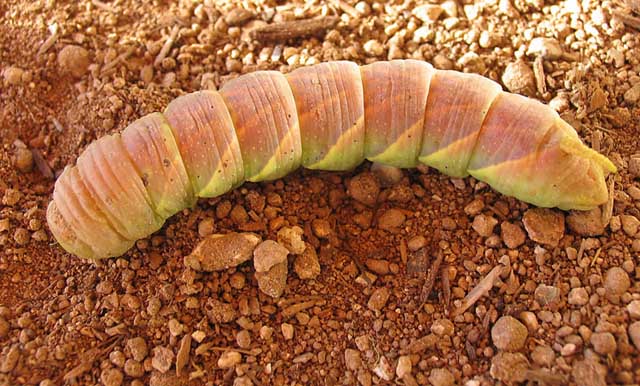Sphinginae subfamily
Sphingini tribe:
 |
Agrius cingulata, USGS, Pink-spotted Hawkmoth:
Very strong flier, and make its way to southern Arizona and southern California. It is confirmed for Pima County and neighbouring counties. |
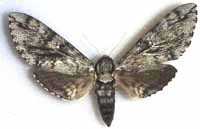 |
Ceratomia sonorensis,
USGS/IN/ER, Sonoran Sphinx:
Forewing fringes: checkered black and white. Fw upperside: dark gray with black bars and dashes and whitish patches. Hw upperside:
dark brown with pale gray at base; has two black transverse lines. rare |
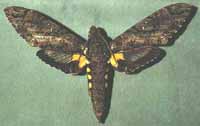 |
Cocytius antaeus, BW Giant Sphinx, stray:
This moth is a very strong flier, but would only make its way to Pima County as a rare stray. There is a single record for Tucson in October (Bruce Walsh).
|
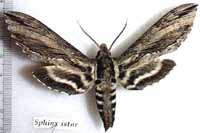 |
Lintneria istar WO/IN, Istar Sphinx:
Fw upperside: dark gray with brown tinges. Series of narrow dashes runs from tip to cell spots; wide black band runs from middle of
outer margin to wing base. Flies to east and south; might be present. |
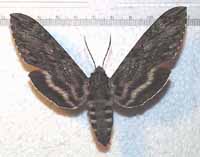 | Lintneria separatus
USGS, Separated Sphinx: The upperside of the forewing is dark gray with black and light gray
wavy lines. The upperside of the hindwing is black with a brownish gray border and two white bands. |
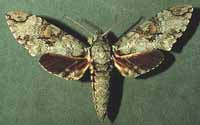 | Manduca florestan:
USGS/IN/ER Forewing upperside: gray to yellowish gray to brown.
Reddish brown patch just outside cell, above dashes is most distinguishing character. |
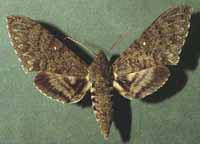 | Manduca muscosa
USGS/IN/ER, Muscosa Sphinx: Moth upperside: soft greenish gray; forewing has
small green to white cell spot; hindwing has black bands and black patch at base. |
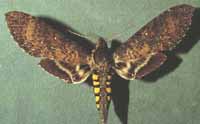 | Manduca occulta
USGS, Occult sphinx: Differentiated from M. sexta which has 2/3 black, 1/3 white checkering on
forewing; occulta has equal amounts of black and white checkering. |
 | Manduca quinquemaculatus
USGS/ER, Five-spotted Hawkmoth: Confirmed in Pima County, and
has been seen in nearby counties. I suspect if you grow tomatoes, you are likely to encounter it. |
 | Manduca rustica
DB/AF/IN/ER/JM/ USGS, Rustic Sphinx: Officially recorded in Pima County;
taken in other nearby counties. Look for three large yellow spots on each side of the abdomen. |
Manduca rustica, Tucson, August 24, 2013, Justin Myser.
 |
Manduca sexta
USGS/IN/ER, Carolina Sphinx:
This species is recorded in Pima County.
If you grow tomatoes, you have probably encountered it, though.
Larvae get very large and can strip a tomato plant.
|
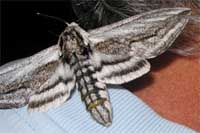 |
Sagenosoma elsa USGS, Elsa sphinx: Recorded in Pima County.
The upperside of the forewing has a wide white band along the costa from base to apex. The remainder of the wing has black and white bands. |
 |
Sphinx chersis USGS/IN,
Northern Ash Sphinx or Great Ash Sphinx: Reported in Pima. Larval hosts are ash, lilac, privet, cherry, quaking aspen.
|
Sphinx chersis, Tucson, July 25, 2009, Meg Benhase.
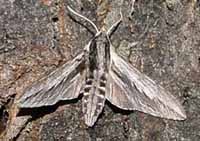 |
Sphinx dollii USGS/IN/ER,
Doll's sphinx: Wing span: 1 3/4 - 2 1/2 inches (4.5 - 6.3 cm), flies in arid brushlands, desert foothills from Nevada and
southern California east through Utah, Arizona, Colorado, New Mexico to Oklahoma and Texas. |
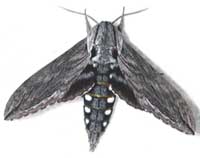 |
Sphinx libocedrus USGS, Incense Cedar Sphinx: Fw upperside: pale blue-gray to dark gray with black dash
reaching wing tip; white stripe along lower outer margin. Hw upperside: black with two diffuse white bands, upper one being practically non-existent.
|
Smerinthini Tribe:
 |
Pachysphinx occidentalis USGS/ER/JM, Big Poplar Sphinx:
This one is quite similar to Pachysphinx modesta, with modesta being smaller and darker.
Moths should be on the wing from June-August. |
Pachysphinx occidentalis, south of Tucson, March 19-20, 2015, Jeanne Marker.
 |
Paonias myopsUSGS/IN/ER, Small-eyed Sphinx:
Named for the small eye-spot in the hindwing, this moth has wide distribution and is probably common in Pima County. |
 |
Smerinthus cerisyi USGS/ER, Cerisyi's
Sphinx or One-eyed Sphinx: Larvae feed on poplars and willows. Flight would be from late May-July as a single brood. |
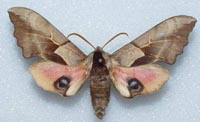 |
Smerinthus saliceti USGS/IN/ER, Salicet
Sphinx, flies in valleys and along streamsides from Mexico City north to west Texas, southern Arizona, extreme southern California.
Larvae feed on poplars and willows. Flight would be from late April-September, probably as a double brood. |
Macroglossinae subfamily
Dilophonotini tribe:
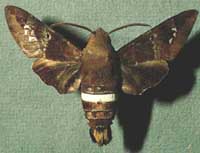 |
Aellopos clavipes USGS, the Aellopos Sphinx.
The body is dark brown with a wide white band across the abdomen. Wings are dark brown. The forewing has a
black cell spot and 3 white spots near the pale brown marginal area. |
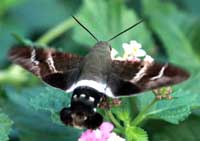 |
Aellopos titan USGS, the Titan Sphinx.
The body is dark brown with a wide white stripe across the abdomen. The wings are dark brown. It is very similar to above species, but the
upperside of the hindwing has pale patches along the costa and inner margin. |
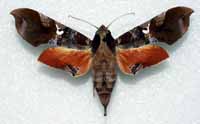 |
Callionima falcifera USGS
This species is reddish, has falcate wings and flies after midnight.It is confirmed for Pima County. |
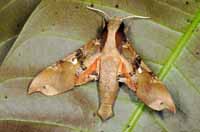 |
Callionima parce WO, the Parce sphinx.
This species is easily confused with C. falcifera and may or may not be present in Arizona.
See the species file. |
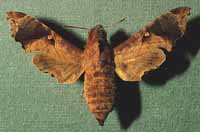
|
Enyo lugubris, the Mournful Sphinx,
USGS
The body and wings are dark brown. The forewing has a large black
patch covering most of the outer half of the wing. There is a pale
tan cell spot (dark inner pupil), and a fairly straight median line
to the inside of the cell spot.
|
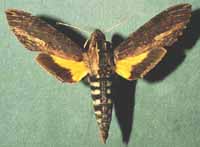
|
Erinnyis alope, the Alope Sphinx,
USGS.
The upperside of the forewing is dark brown with short yellowish
streaks on the forward half and wavy yellowish bands on the rear
half.
The upperside of the hindwing is bright yellow with a wide dark brown border.
|
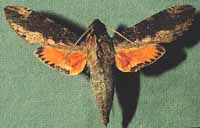 |
Erinnyis crameri, the Cramer's Sphinx,
USGS.
The upperside of the abdomen is gray, without black bands, and
the underside does not have black spots. The upperside of the
forewing is dark brown, and may have pale yellow-brown patches
along the inner edge.
|
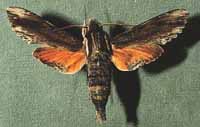 |
Erinnyis domingonis
WO, the Dominican Sphinx.
This moth flies in Haiti and Jamaica south to Paraguay and Bolivia
with occasional sightings in Texas and Arizona.
This species
might be present in Pima County.
|
 |
Erinnyis ello
USGS/ER, the Ello Sphinx.
This species is reported in Pima County and in other southern
Arizona counties.
Males and females differ. rare
|
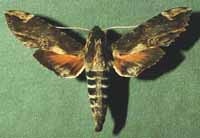 |
Erinnyis lassauxi
WO, the Dominican Sphinx.
This moth flies in Haiti and Jamaica south to Paraguay and Bolivia
with occasional sightings in Texas and Arizona.
This species
might be present in Pima County.
|
 |
Erinnyis obscura, the Obscure Sphinx,
USGS.
During the night adults nectar at flowers, including bouncing bet
(Saponaria officinalis) and Asystasia gangetica beginning at dusk.
July and August are flight times in the southern states.
|
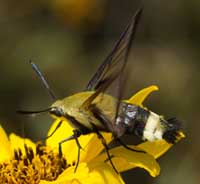 |
Hemaris thetis WO, the Thetis Clearwing or Bee Hawk Moth.
The moth flies along forest edges and in meadows, gardens and
brushy fields. Day-flying adults nectar at lantana, dwarf bush honeysuckle,
snowberry, orange hawkweed, thistles, lilac, Canada violet, etc.
|
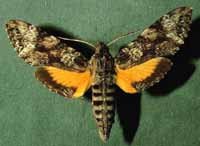 |
Isognathus rimosa, the Rimosus Sphinx,
USGS. Fw upperside of female mostly gray brown on front
half, dark brown on rear half while male fw upperside is yellow gray or gray brown. Both sexes have wavy dark
markings. Hw upperside of both sexes yellow with an incomplete dark border on outer margin. |
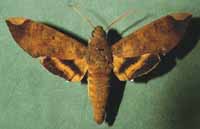 |
Pachylia ficus, Fig Sphinx, USGS.
Fw upperside orangish brown with paler patch along costa tip. The upperside of
the hindwing is orange to orangish brown with a black outer border, a black median band, and a white spot on the outer margin near the body. |
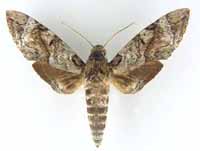 |
Pseudosphinx tetrio, Tetrio Sphinx, USGS.
The upperside of the forewing is dark brown with a dark spot at the base of the costa and blurry gray and white markings. The upperside
of the hindwing is dark brown with white along the inner margin, and the lower half of the outer margin. |
Philampelini tribe:
 |
Eumorpha achemon DB/IN/ER/ USGS, Achemon Sphinx.
This moth is officially reported for Pima County. Eumorpha achemon larvae feed upon Grape (Vitis),
Virginia Creeper (Parthenocissus quinquefolia) and other vines and ivies (Ampelopsis). |
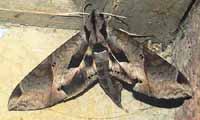 |
Eumorpha satellitia USGS, Satellite Sphinx.
The Satellite Sphinx Moth, Eumorpha satellitia satellitia flies in Jamaica and from Mexico to Ecuador and further south into Bolivia.
stray |
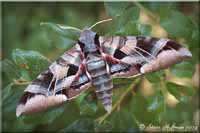 |
Eumorpha typhon USGS/IN/ER, Typhon Sphinx.
The upperside of wings is deep red-brown with pale brown bands. Each hindwing has pink along
the costal margin and a triangular white spot on the outer part of the inner margin. |
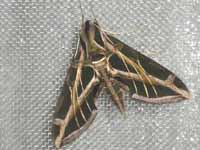 |
Eumorpha vitis USGS/IN, Vine Sphinx.
The upperside of the moth is dark pinkish brown. Each forewing has a lighter brown band along the costa, and sharp pinkish white bands and
streaks. The hindwing has a pink patch on the inner margin. |
Macroglossini tribe:
 |
Hyles lineata DB/AF/IN/ER/USGS,
the White-lined Sphinx. Adam Fleishman reports many August 11-21 in Tucson, Arizona.
David Bygott sent a larva image in April. Larvae can be quite varied. |
Adam Fleishman reports large numbers of Hyles lineata,
August 21, 2005, SE Tucson.
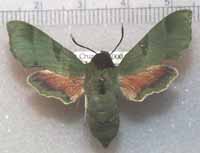 |
Proserpinus terlooii USGS/IN/ER, Terloo sphinx.
The upperside of the forewing is uniform olive green with a darker median band. The upperside of the hindwing
is red with an olive green border. |
Proserpinus terlooii - 1 male, 1 female Brown Canyon, Baboquivari Mountains, 30-31 July 2010, Evan Rand
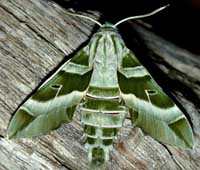 |
Proserpinus vega USGS, Vega sphinx.
Jim Tuttle writes, "P. vega has a very large and dark basal patch as the FW meets the thorax that is lacking in terlooii.
There are also three prominent longitudinal stripes on the thorax of vega that are lacking in terlooii." |
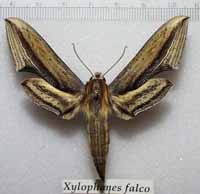
|
Xylophanes falco USGS/IN/ER, Falcon Sphinx.
Fw upperside orange-brown along forward half, striped with dark brown and light brown along
rear half, with dark brown bands separating the two. Hw upperside of the hindwing is pale brown with dark brown
marginal and submarginal lines. |
|
|
